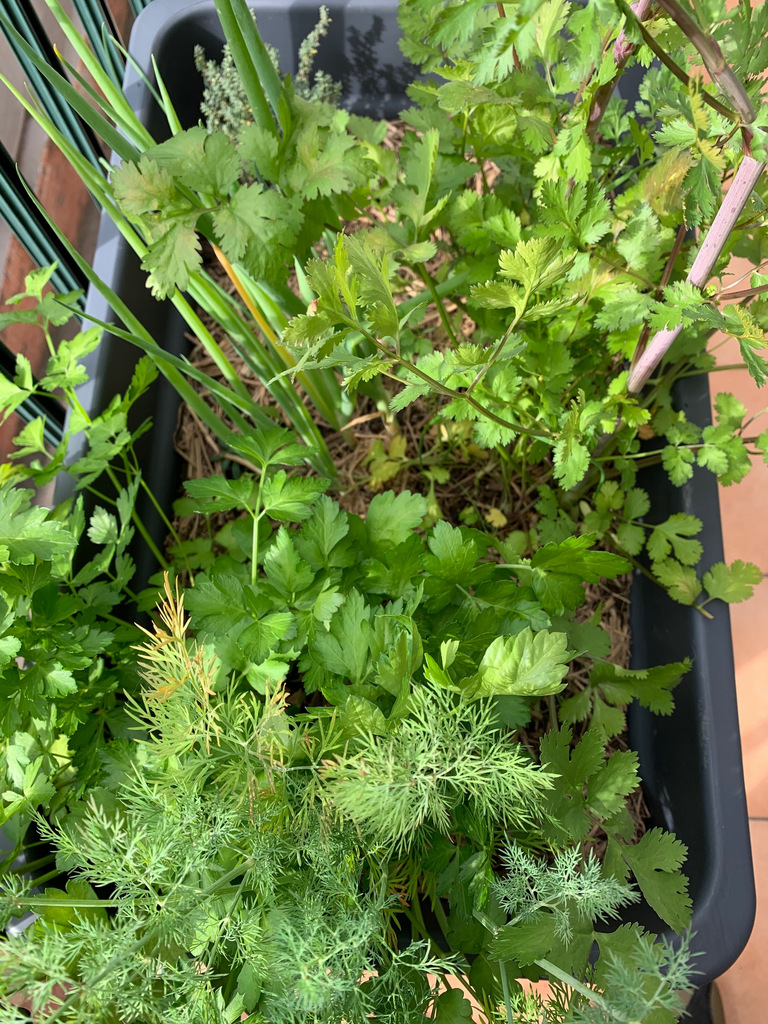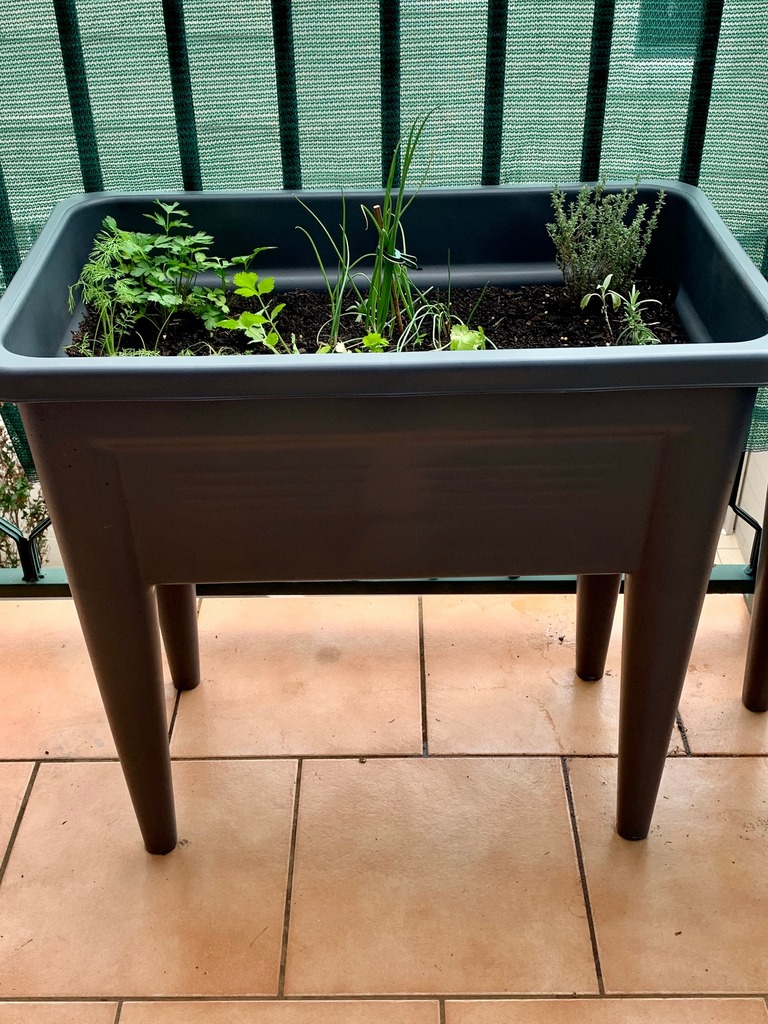When it comes to growing a herb garden it’s all about location location location! Here’s an easy way to start a balcony herb garden in a raised garden planter.

Balcony Herb Garden – Photo © The Gourmantic Garden
New gardeners are often advised to grow a herb garden that’s located next to the kitchen. For many years, I’ve been growing herbs mainly in pots in my courtyard garden and it’s nowhere near the kitchen. Living in an urban setting, the kitchen is located upstairs and every time I need herbs for cooking, I’m either too lazy to walk downstairs or it’s too dark during the winter months and the likelihood of grabbing a slug with my sage is fairly high.
I finally decided to start a balcony herb garden which is off the dining room/kitchen. The balcony is tiny that I can’t take a decent photo of it. However, it faces north and gets ample sunlight throughout the year.

Balcony Herb Garden in Raised Garden Planters – Photo © The Gourmantic Garden
I’ve had success with growing edibles in raised garden planters which I bought from Bunnings last year but they’ve been unavailable since. When they finally had them back in stock, I no longer had an excuse to delay setting up my balcony herb garden.
The raised container is made of durable plastic and measures 697mm long x 425mm wide x 655mm high. It’s a good size for small balconies like mine and I can easily fit two side by side. The height is convenient which it provides easy access with less bending if you have a bad back. Note: This is not sponsored, just sharing what I use in case it inspires someone to start their own balcony herb garden.
Enough with that, let’s get planting!
How to Start a Balcony Herb Garden
I filled up the container with previously used potting mix at the base. Unless the previous plants had a disease or the soil had some infestation, I always reuse and rejuvenate the soil. It’s part of the ethos of The Gourmantic Garden to reuse, repurpose and recycle where possible. I then added mushroom compost, blood and bone, and topped up with fresh potting mix. I gave it all a good mix before it started to rain which means I had to abandon it and let nature take its course.
Once the raised garden planter was set up, it was time to transplant the herbs. I had some growing in individual pots, others I had propagated or were in the process of propagation. Here’s what it looks like at the moment of writing this article:

Balcony Herb Garden Layout – Photo © The Gourmantic Garden
Here’s the set up row by row:
| Thyme | Sage | Rosemary |
| French Tarragon | Chives | Coriander |
| Parsley | Dill | Garlic Chives |
The herbs are in various stages of growth. Some I’ve had in pots, others are currently being propagated.
- Top Row: Thyme (propagated by division), Sage (in propagation), Rosemary (propagated)
- Middle Row: French Tarragon (in propagation), Chives (grown from seed), Coriander/Cilantro (grown from seed)
- Bottom Row: Parsley, Dill, Garlic Chives (all grown from seed)
I also filled some gaps with seed. Once they’ve had a chance to get established, I will add sugarcane mulch. It’s worth noting that the French Tarragon has a habit of spreading out so I’m attempting to grow it vertically.
You may notice that I didn’t fill the planter right up to the top. This is because most of the herbs have shallow roots and I wanted a little wind buffer as the balcony can get quite windy in winter and that’s on top of the sea breeze it gets in the afternoon.
Which Herbs Can Be Planted Together
If you take a closer look, you’ll see that I grouped herbs together based on their watering requirements. Mediterranean herbs like Thyme, Sage and Rosemary like dry soil so I’ve planted them together on the right hand side. Soft stemmed herbs like parsley, coriander/cilantro, basil and chives like moist soil so I can water them together at the same rate.
There are a few herbs you don’t want to grow together in a set up like this. Here are three main culprits which I have growing in their own containers:
1. Mint
Mint in all its varieties takes up the whole garden bed. Its roots spread and entangle everything else. I grew it once in the garden bed and it took me years to get rid of all the roots. It is best confined to its own container.
2. Oregano
Like mint, oregano has a habit of spreading wide and fast and is better suited to its own container.
3. Fennel
The fennel herb is a loner and doesn’t play well with other herbs so it’s best to give it its own space.
Benefits of a Balcony Herb Garden in a Raised Planter
When it comes to having a balcony herb garden, you can grow a variety of herbs in various pots having them together in one raised planter has many advantages. At that height, they’re very accessible and it’s much more convenient when it comes to watering them. Plants in small pots dry out faster and therefore need to be watered more frequently. After the drought and water restrictions Sydney had last summer, I implemented water saving measures in the garden which you can read about here. Granted a lot of it required a bit of physical effort so I’m always looking for ways that are smarter and easier.
Having a balcony herb garden at my fingertips is a huge advantage. And when I save the water I use in the kitchen to rinse vegetables, I can easily reuse it to water the herb garden when needed.
As for the second planter on the balcony, I may use it in the interim to grow vegetables from kitchen scraps. This will be until summer comes along and I can grow a dwarf tomato plant surrounded by various types of basil and marigold.
(Note: The photos in this article were taken in a hurry while it was raining and blowing a gale in Sydney. I will update with better images once my balcony herb garden has had time to get established.)

